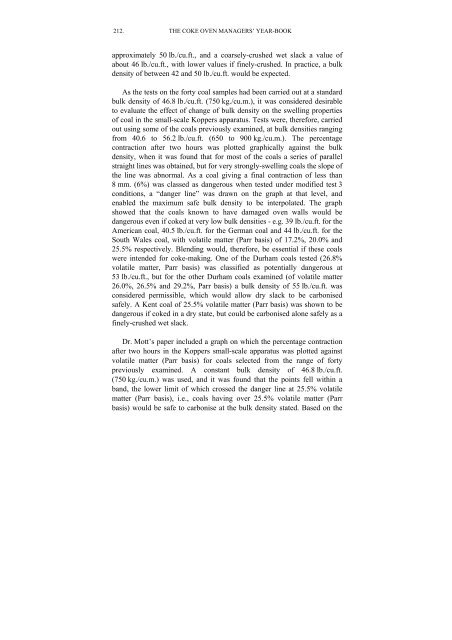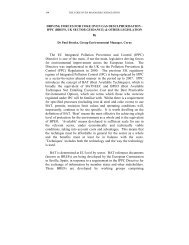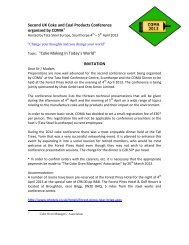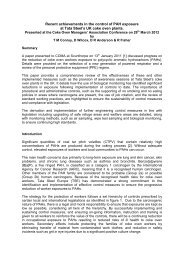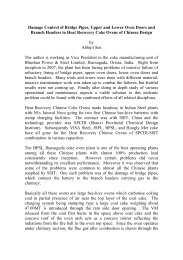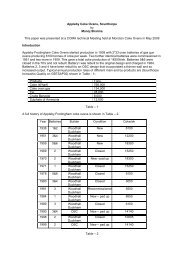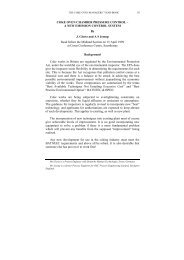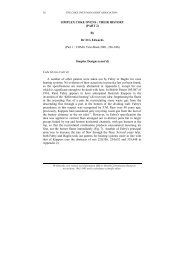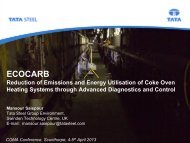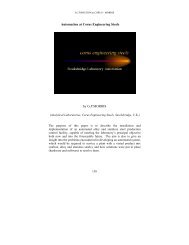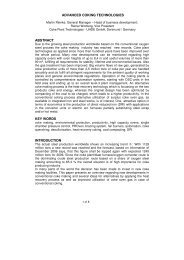CHAIRMAN'S ADDRESS - Coke Oven Managers Association
CHAIRMAN'S ADDRESS - Coke Oven Managers Association
CHAIRMAN'S ADDRESS - Coke Oven Managers Association
- No tags were found...
You also want an ePaper? Increase the reach of your titles
YUMPU automatically turns print PDFs into web optimized ePapers that Google loves.
212. THE COKE OVEN MANAGERS’ YEAR-BOOKapproximately 50 lb./cu.ft., and a coarsely-crushed wet slack a value ofabout 46 lb./cu.ft., with lower values if finely-crushed. In practice, a bulkdensity of between 42 and 50 lb./cu.ft. would be expected.As the tests on the forty coal samples had been carried out at a standardbulk density of 46.8 lb./cu.ft. (750 kg./cu.m.), it was considered desirableto evaluate the effect of change of bulk density on the swelling propertiesof coal in the small-scale Koppers apparatus. Tests were, therefore, carriedout using some of the coals previously examined, at bulk densities rangingfrom 40.6 to 56.2 lb./cu.ft. (650 to 900 kg./cu.m.). The percentagecontraction after two hours was plotted graphically against the bulkdensity, when it was found that for most of the coals a series of parallelstraight lines was obtained, but for very strongly-swelling coals the slope ofthe line was abnormal. As a coal giving a final contraction of less than8 mm. (6%) was classed as dangerous when tested under modified test 3conditions, a “danger line” was drawn on the graph at that level, andenabled the maximum safe bulk density to be interpolated. The graphshowed that the coals known to have damaged oven walls would bedangerous even if coked at very low bulk densities - e.g. 39 lb./cu.ft. for theAmerican coal, 40.5 lb./cu.ft. for the German coal and 44 lb./cu.ft. for theSouth Wales coal, with volatile matter (Parr basis) of 17.2%, 20.0% and25.5% respectively. Blending would, therefore, be essential if these coalswere intended for coke-making. One of the Durham coals tested (26.8%volatile matter, Parr basis) was classified as potentially dangerous at53 lb./cu.ft., but for the other Durham coals examined (of volatile matter26.0%, 26.5% and 29.2%, Parr basis) a bulk density of 55 lb./cu.ft. wasconsidered permissible, which would allow dry slack to be carbonisedsafely. A Kent coal of 25.5% volatile matter (Parr basis) was shown to bedangerous if coked in a dry state, but could be carbonised alone safely as afinely-crushed wet slack.Dr. Mott’s paper included a graph on which the percentage contractionafter two hours in the Koppers small-scale apparatus was plotted againstvolatile matter (Parr basis) for coals selected from the range of fortypreviously examined. A constant bulk density of 46.8 lb./cu.ft.(750 kg./cu.m.) was used, and it was found that the points fell within aband, the lower limit of which crossed the danger line at 25.5% volatilematter (Parr basis), i.e., coals having over 25.5% volatile matter (Parrbasis) would be safe to carbonise at the bulk density stated. Based on the


